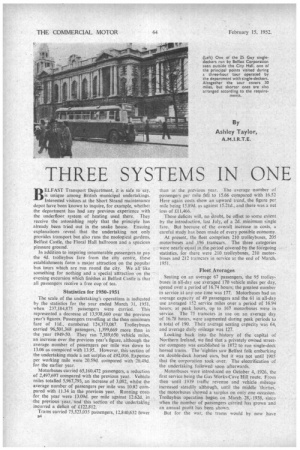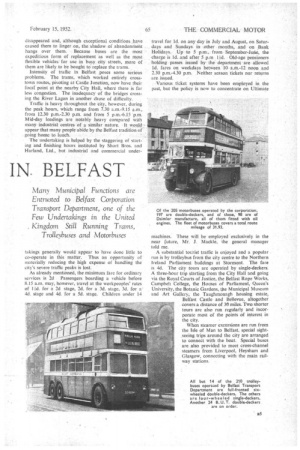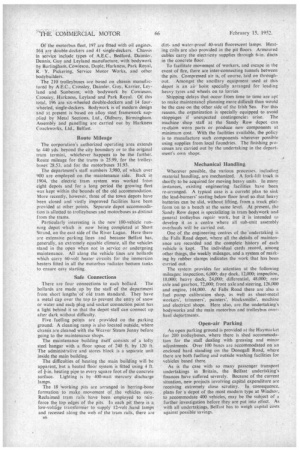THREE SYSTEMS IN ONE IN BELFAST
Page 38

Page 39

Page 40

If you've noticed an error in this article please click here to report it so we can fix it.
Many Municipal Functions are Entrusted to Belfast Corporation Transport Department, one of the Few Undertakings in the United
. Kingdom Still Running Trams, Trolleybuses and Motorbuses
BELFAST Transport Department, it is safe to say, is unique among British municipal undertakings. Interested visitors at the Short Strand maintenance depot have been known to inquire, for example, whether the department has had any previous experience with the underfloor system of heating used there. • They receive the astonishing reply that the principle has already been tried out in the snake house. Ensuing explanations reveal that the undertaking not only provides transport but also runs the zoological gardens, Belfast Castle, the Floral Hall ballroom and a spacious
pleasure ground. ..
In addition to inspiring innumerable passengers to pay the 4d. trolleybus fare from the city centre, these establishments form a major attraction on the popular bus tours which are run round the city. We all like something for nothing and a special attraction on the evening excursion which finishes at Belfast Castle is that all passengers receive a free cup of tea.
Statistics for 1950-1951 The scale of the undertaking's operations is indicated by the statistics for the year ended March 31, 1951, when 237,184,875 passengers were carried. This represented a decrease of 13,938,660 over the previous year's figures. Passengers travelling at the then minimum fare of 11d., numbered 124,373,087. Trolleybuses carried 96,501,30 pasengcrs, 1,399,669 more than in the year 1949-50. They ran 7,389,650 vehicle miles, an increase over the previous year's figure, although the average number of passengers per mile was down to 13.06 as compared with 13.95. However, this section of the undertaking made a net surplus of £92,016. Expenses per working mile were 20.59d. compared with 20.49d. for the earlier year.
Motorbuses carried 65,160,472 passengers, a reduction of 2,497,697 compared with the previous year. Vehicle miles totalled 5,967,793, an increase of 3,082, whilst the average number of passengers per mile was 10.92 coinpared with 11.34 in the previous year. Running costs for the year were I3.09d. per mile against 12.62d. in the previous year, and thissection of the undertaking incurred a deficit of 1122,812.
Trams carried 75,523,035 paSsengers, 12,840,632 fewer 84 than in • the previous year. The average •number of passengers per mile fell to 15.66 compared with 16.52 Here again costs show an upward trend, .the figure per mile being 15.89d. as against 15.2 Id., and there was a net loss of £11,466.
These deficits will, no 'doubt, be offset to some extent by the introduction, last July, of a 2d. minimum single fare. But because of the overall increase in costs, a careful study has been made of every possible economy.
At present, the fleet comprises 210 trolleybuses, 205 motorbuses and .196 tramcars. The three categories were nearly equal'in.the period covered by the foregoing statistics, for there were 210 trolleybuses, 210 motorbuses and 212 tramcars in service at-the end of March, 1951.
Fleet Averages
Seating on an average 67 passengers, the 95 trolleybuses in all-day use averaged 170 vehicle miles per day, spread over a period of 16.74 hours; the greatest number in service at any one time was 177. Motorbuses had an average capacity of 49 passengers and the 611n all-day use averaged 152 service miles over a period of 16.94 hours; at peak hours, Up to 167 motorbuses were in service. The 75 tramcars in use on an average day of 16.78 hours, were augmented during peak periods to a total of 190. Their average seating capacity was 64, and .average daily mileage was 127.
Looking back into:the history of the capital of Northern Ireland, we find that a privately owned streetcar company was established in 1872 to run single-deck horsed trains. The 'eighties saw Belfast folk embarking on double-deck horsed cars, but it was not until 1905 that the corporation took. over. The electrification of the undertaking followed soon afterwards,
Motorbuses were introduced on October 4, 1926, the first service being the Gas Works-Cave Hill route. From then until .1939 traffic revenue and vehicle mileage increased steadily although, until the middle 'thirties, the motorbuses showed a surplus on only one occasion. Trolleybus operation • began on March 28,1938, since when • the number of passengers carried has grown and an annual profit has been shown.
But for the war, the trams would by now have
disappeared and, although exceptional conditions have caused them to linger on, the shadow of abandonment hangs over them. Because buses are the most expeditious form of replacement as well as the most fleabite vehicles for use in busy, city. streets, more of them are likely to be bought to replace the trams.
Intensity of traffic in Belfast poses some serious problems.. The trams, which worked entirely crosstown routes,pivoting at. Castle Junction, now have, their focalpoint at the nearby City Hall, when there is far less congestion. The inadequacy of the bridges crossing the River Lagan in another use of difficulty.
Traffic is heavy throughout the city, however, during the peak hours, which range from 7.30 a.m.-9.15 a.m., from 12.30 p.m.-2.30 p.m. and from 5 p.m.-6.15 p.m. Mid-day loadings are notably heavy compared with many industrial centres of a -similar nature.
appear: that many people abide by the Belfast tradition of going home to lunch.
The undertaking -is helped by -the staggering of starting and finishing hours instituted by Short Bros. and Harland, Ltd., but industrial and commercial under
takings generally would appear to have done little to co-operate in this matter. Thus an opportunity of materially reducing the high expense of handling the city's severe traffic peaks is lost.
As already mentioned, the minimum fare for ordinary services is 2d Passengers boarding a vehicle before 8.15 a.m, may, however, travel at the workpeoples' rates of 1,1d. for a 2d stage, 2d. for a 3d. stage, 3d. for a' 4d. stage and 4d. for a 5d. stage. Children under 14
travel for id, on any day in July and August, on Saturdays and Sundays in other months, and on Bank Holidays. Up to 5 p.m., from September-June, the charge is ld. and after 5 p.m 11d. Old-age pensioners holding passes issued by the department areallowed Id. fares on weekdays between 10 a.m.-12 noon and 2.30 p.m.-4.30 p.m. Neither season tickets nor returns are issued.
Various ticket systems have been employed in the past, but the policy is now to concentrate on Ultimate machines. These will be employed exclusively, in the near future, Mr. J. Mackie, the general manager told me.
A substantial tourist traffic is enjoyed and a popular run is by trolleybus from the city centre to the Northern Ireland Parliament buildings at Stormont. The fare is 4d. The city tours are operated by single-deckers. A three-hour trip starting from the City Hall and going via the Royal Courts of Justice, the Belfast Rope Works, Campbell College, the Houses of Parliament, Queen's University, the Botanic Gardens, the Municipal Museum and Art Gallery, the Taughmonagh housing estate, Belfast Castle and Bellevue, altogether covers a distance of 30 miles. Two shorter tours are also run regularly and incorporate most of the points of interest in the city.
When steamer excursions are run from the Isle of Man to Belfast, special sightseeing trips around the city are arranged to connect with the boat. Special buses are also provided to meet cross-channel steamers from Liverpool, Heysham and Glasgow, connecting with the main railway stations.
Of the motorbus fleet, 197 are fitted with oil engines. 164 are double-deckers and 41 single-deckers. Chassis in service include types of A.E.C., Bedford, Daimler, Dennis, Guy and Leyland manufacture, with bodywork by Burlingham, Cowieson, Duple, Harkness, Park Royal, R. Y. Pickering, Service Motor Works, and other bodybuilders.
The 210 trolleybuses are based on chassis manufactured by AEC., Crossley, Daimler, Guy, Karrier, Leyland and Sunbeam, with bodywork by Cowieson, Crossley, Harkness, Leyland arid Park. Royal. Of this total, 196 are six-wheeled double-deckers and 14 fourwheeled, single-deckers. Bodywork is of modern design and at present is based on alloy steel framework supplied by Metal Sections, Ltd., Oldbury, Birmingham. Assembly and panelling are carried out by Harkness Coachworks, Ltd., Belfast.
Route Mileage The corporation's authorized operating area extends to 440 yds. beyond the city boundary or to the original tram termini, whichever happens to be the further. Route mileage for the trams is 25.99, for the trolleybuses 28.53, and for the motorbuses 31.93.
The department's staff numbers 3,980, of which over 900 are employed on the maintenance side. Back in 1904, the electric tram system was worked froni eight depots and for a long period the growing fleet was kept within the bounds of the old accommodation. More recently, however, three of the town depots have been closed and vastly improved facilities have been provided at other points. Separate depot accommodation is allotted to trolleybuses and motorbuses as distinct from the trams.
Particularly interesting is the new 180-vehicle running depot which is now being completed at Short Strand, on the east side of the River Lagan. Here there are extensive parking lines • and because Belfast has, generally, an extremely equable climate, all the vehicles stand in the open when not in service or undergoing maintenance. All along the vehicle lines are bollards which carry 60-volt heater circuits for the immersion heaters fitted in all the motorbus radiator bottom tanks to ensure easy starting.
Safe Connections There are four connections to each bollard. The bollards are made up by the staff of the department from short lengths of old tram standard. They have a metal cap over the top to prevent the entry of snow or water and eacb plug and socket connection point has a light behind it so that the depot staff can connect up after dark without difficulty.
Five fuelling points are provided on the parking ground. A cleaning ramp is also located outside, where chassis are cleaned with the Weaver Steam Jenny before going to the maintenance shops.
The maintenance building itself consists of a lofty steel hangar with a floor space of 240 ft. by 120 ft. The administrative and stores block is a separate unit inside the main building.
The difficulties of heating the main building will be apparent, but a heated floor system is fitted using 4 ft. of i-in. heating pipe to every square foot of the concrete surface. Lighting is by 400-watt mercury discharge lamps.
The 18 'working pits are arranged in herring-bone formation to make movement of the vehicles easy. Reclaimed tram rails have been employed to reinforce the top edges of the pits. In each pit there is a. low-voltage transformer to supply 12-volt hand lamps and recessed along the web of the tram rails, there are n6 dirtand water-proof 40-watt fluorescent lamps. Heating coils are also provided in the pit floors. Armoured cables carry the electricity supplies through 6-in. ducts in the concrete floor.
To facilitate movement of workers, and escape in the event of fire, there are inter-connecting tunnels between the pits. Compressed air is, of course, laid on throughout. Amongst the ancillary equipment used at this depot is an air hoist specially arranged for loading heavy tyres and wheels on to lorries.
Shipping delays that occur from time to time are apt to make maintenand planning more difficult than would be the case on the other side of the Irish Sea. For this reason, the organization is specially equipped to avoid stoppages if unexpected contingencies arise. The machine shop staff at the Sandy Row depot can re-claim worn parts or produce new components at minimum cost. With the facilities available, the policy is to manufacture such components wherever possible using supplies from local foundries. The finishing processes are carried out by the undertaking in the department's own shops.
Mechanical Handling
Wherever possible, the various processes. including material handling, are mechanized. A fork-lift truck is shortly to be acquired for moving heavy units. In many instances, existing engineering facilities have been re-arranged. A typical case is a curreht plan to sink the lead-burners' seating below floor level so that heavy batteries can be slid, without lifting, from a truck platform on to a bench at the same level. At present, the Sandy Row depot is specializing in tram bodywork and general trollevbus repair work, but it is intended to develop it as a centre where all sub-unit assembly overhauls will be carried out.
One of the engineering centres of the-undertaking is the Falls Road depot. where all the details of maintenance are recorded and the complete history of each vehicle is kept. The individual cards record, among other things, the 'weekly mileages, and a system of marking by rubber stamps indicates the work that has been carried out.
The system provides for attention at the following mileages: inspection, 6,000; day dock, 12,000; inspection, 18,000; heavy dock, 24,000; differential, 48,000; rear axle and gearbox, 72,000; front axle and steering, 126,000 and engine, 144,000. At Falls Road there are also a fuel pump calibration shop, as well as sheet-metal workers', trimmers', painters', blacksmiths', machine and electrical shops. Here also, are the undertaking's bodyworks and the main inotorbus and trolleybus overhaul departments.
Open-air Parking
An open parking ground is provided at the Haymarket for 200 trolleybuses, where there is shed accommodation for the staff dealing with greasing and minor adjustments. Over 100 buses are accommodated on an enclosed hard standing on the Donegan Road, where there are both fuelling and outside washing facilities for vehicles based there.
As is the case with so many passenger transport undertakings in Britain, the Belfast undertaking's finances have suffered severely. Because of the current situation, new projects involving capital expenditure are receiving extremely close scrutiny. In consequence, plans for a depot of the most modern type at Windsor, to accommodate 400 vehicles, may be the subject of a further investigation before they are put into effect. As with all undertakings, Belfast has to weigh capital costs against possible savings.




















































































